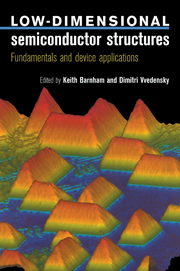Book contents
- Frontmatter
- Contents
- List of contributors
- Preface
- 1 Epitaxial Growth of Semiconductors
- 2 Electrons in Quantum Semiconductor Structures: An Introduction
- 3 Electrons in Quantum Semiconductors Structures: More Advanced Systems and Methods
- 4 Phonons in Low-dimensional Semiconductor Structures
- 5 Localization and Quantum Transport
- 6 Electronic States and Optical Properties of Quantum Wells
- 7 Non-Linear Optics in Low-dimensional Semiconductors
- 8 Semiconductor Lasers
- 9 Mesoscopic Devices
- 10 High-speed Heterostructure Devices
- Solutions to Selected Exercises
- Index
8 - Semiconductor Lasers
Published online by Cambridge University Press: 06 July 2010
- Frontmatter
- Contents
- List of contributors
- Preface
- 1 Epitaxial Growth of Semiconductors
- 2 Electrons in Quantum Semiconductor Structures: An Introduction
- 3 Electrons in Quantum Semiconductors Structures: More Advanced Systems and Methods
- 4 Phonons in Low-dimensional Semiconductor Structures
- 5 Localization and Quantum Transport
- 6 Electronic States and Optical Properties of Quantum Wells
- 7 Non-Linear Optics in Low-dimensional Semiconductors
- 8 Semiconductor Lasers
- 9 Mesoscopic Devices
- 10 High-speed Heterostructure Devices
- Solutions to Selected Exercises
- Index
Summary
Introduction
Previous chapters in this book have described in detail how low-dimensional structures affect the optical properties of semiconductor materials. It should therefore be no surprise to readers to find that the main applications of low-dimensional materials have been in optical devices which emit light – particularly the semiconductor laser. The semiconductor laser, even without the use of low-dimensional structures, has become the most common form of laser and new operating wavelengths; new characteristics and new applications appear at an amazing rate. This chapter could not hope to provide a comprehensive review of all these developments. Specialist texts (Agrawal, 1986; Zory, 1993; Coldren and Corzine, 1995) will do that far more effectively. Instead we hope to introduce some of the key concepts, presented in the context of developments in semiconductor physics, which will lead the reader to the more advanced texts. Consequently, many of the sources quoted are review papers and not the original texts.
Many of the advances in low-dimensional semiconductors have been motivated by the fascinating new range of physical phenomena which arise when electrons and holes are confined in very small dimensional structures (Bastard, 1988; Schmitt-Rink et al., 1989; Weisbuch and Vinter, 1991). Advances in semiconductor lasers have driven this fascination, but there has also been a clear focus for the development. The most important of these, to date, has been the need to develop very high-performance semiconductor lasers for optical-fibre-based communication systems (Koch and Koren, 1990).
- Type
- Chapter
- Information
- Low-Dimensional Semiconductor StructuresFundamentals and Device Applications, pp. 260 - 295Publisher: Cambridge University PressPrint publication year: 2001



